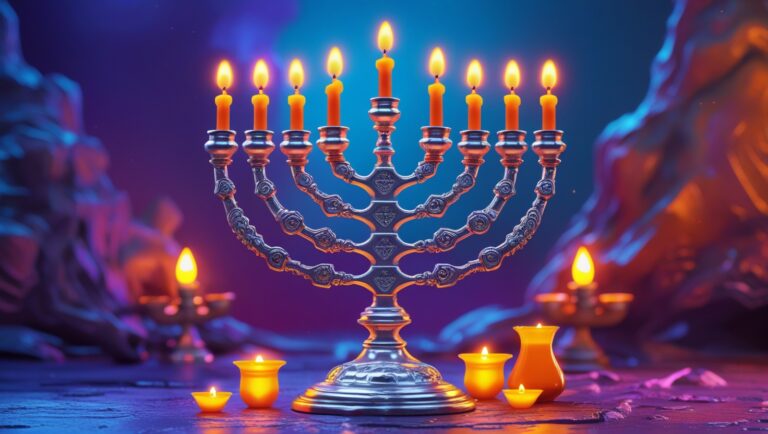Introduction to Gematria in Torah Interpretation
Gematria is a mystical practice that assigns numerical values to letters, words, and phrases in the Hebrew language. This practice is based on the fact that words and letters have intrinsic spiritual meanings, and are connected to each other. Much of Kabbalah and Rebbe Nachman’s Torah, especially in Likutey Moharan, is based on this principle.
Numbers connect concepts that share a connection, either the same spiritual source or represent opposite ideas.
The basis of Gematria is the Hebrew alphabet, which consists of 22 letters, each of which has a numerical value. The first letter, Aleph, has a value of one, the second letter, Bet, has a value of two, and so on, up to the final letter, Tav, which has a value of 400. Then we have the Sofiot letters, which sometimes have their base value (of the regular form), and sometimes the value according to the table below:
By studying the numerical values, many hidden insights and connections can be uncovered. In fact, the Pshat (simple meaning) can only really be understood in light of Kabbalah and Gematria.
Moreover, each letter represents a measure of the creative force that’s present in Creation. When combined with other letters, it forms the life essence of the object the final word presents. And that force becomes manifested here in the physical world after the Kabbalistic process known as “Tzimtzum” (constriction).
Gematria is used in various ways to gain insights into the meaning of Hebrew words and phrases.
One common method is to add up the numerical values of the letters in a word or phrase to derive a total value.
As we all know, the Hebrew word for “life” (chai) has a numerical value of 18 (which is also considered a good number in Jewish tradition), since the letters Chet and Yud have values of 8 and 10, respectively. Chet represents life (from the word “Chayut”) and Yod represents unit as it’s often written as a simple dot.
Another method of Gematria involves finding words or phrases that have the same numerical value, which is believed to indicate a connection between them. For example, the Hebrew words for “love” (ahava) and “one” (echad) both have a numerical value of 13, which explicitly points to a connection between these two concepts.
This is the basis for the Kavanah for when we say the word “Echad” in Shema Israel, where we have to lovingly accept Hashem’s kingship. 13 is also the number of Tikkuney Diknah (the “strands of beard”) of the Partzuf of Arich Anpin in Kabbalah.
There are also more complex forms of Gematria, such as using the numerical values of words to create mathematical equations or patterns.
These more intricate methods can reveal even deeper insights into the spiritual significance of Hebrew words and phrases. In fact, we know that the whole Torah is one big name of Hashem, composed of many smaller ones that are interspersed inside the text forming a web/matrix for understanding how the spiritual worlds work. It’s written in the Zohar that the entire Creation is codified in the Torah ( much like computer software uses a programming language to run).
I don’t need to tell you that Gematria is a genuine part of Jewish Tradition, and has been used for centuries (if not millennia). While some skeptics may dismiss it as mere superstition, others find it to be a fascinating tool for uncovering hidden meanings and connections within the Hebrew language.
The Number 40 in Gematria
The number 40 is of great importance in the realm of prayer, where many segulot involve reciting a specific text for 40 consecutive days. This practice is rooted in the Talmud (Yevamot 69b), which teaches that an embryo is considered “mere water” until 40 days after conception. At this point, it begins to resemble a human and can be identified as male or female. As a result, it is believed that couples have 40 days to pray for the gender of their child, after which time any prayer in this regard is considered ineffective and may even result in punishment.
The number 40 is also significant in relation to other notable events, such as the 40 days that Moshe Rabbenu spent on Mount Sinai to receive the Torah and the requirement for a Mikvah to contain 40 Se’ah in order to purify a woman from her Niddah state.
Moreover, the letter “Mem” has a numerical value of 40 and represents the word “Mayim” (Water). This knowledge allows us to better comprehend why the sages consider the first 40 days of an embryo’s development to be “mere water.” The number 40 represents transformation and the process of changing from a fluid state to a solid form.
- Kingship is often associated with the number 40. For example, Moshe Rabbenu led the Israelites for 40 years in the wilderness, and King David ruled over Israel for 40 years.
- The 40 days of the Flood in the story of Noah represent a period of purification and renewal. Just as the world was washed clean of its impurities and given a fresh start, so too can individuals use the number 40 as a symbol of personal renewal and transformation.
- The number 40 is also associated with the sefirah of Yesod, which represents the foundation and basis of the spiritual world. This highlights the idea that the number 40 can serve as a foundation for spiritual growth and development. Many Segulot need to be done 40 times in order to generate a strong enough effect in the spiritual worlds.
- The Talmud teaches that a person should study Torah for 40 years before attaining true understanding. This suggests that the number 40 can symbolize the importance of persistence and dedication in the pursuit of knowledge and wisdom.
A Primer on How Prayer Works
The manifestation of prayers in higher worlds has a parallel structure to the development of a child, with the ultimate goal being to bring forth a new reality. As we have previously discussed, Hashem has created the world in such a way that prayer is a necessary component for spiritual development. The strength and effectiveness of our prayers can be influenced by various factors.
Contrary to popular belief, prayers do not require power to be heard by Hashem. He is obviously aware of all our prayers and could technically fulfill them without our efforts.
However, our world is structured in a way that demands effort in order to build this new reality that we desire.
The merits of the individual praying, their concentration, the time, place, and company they keep, among other factors, can all impact the impression made by the prayer. We will see all these in a different post.
The sages teach that Rachmana Liba Ba’ei, meaning that Hashem desires the heart, and thus we must pour our souls into our prayers to make a strong impression.
As I wrote before, R’ Natan of Nemirov, the primary disciple of Rebbe Nachman of Breslov, taught that praying continuously for 40 days can significantly increase the likelihood of one’s prayers being heard.
I hope you enjoyed this article. We only scratched the surface and only spoke about the number 40 (and haven’t exhausted it), but nevertheless, may we merit to become conduits of Hashem’s light in the world.







